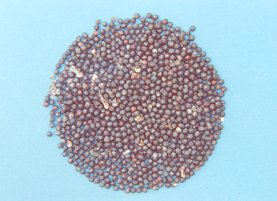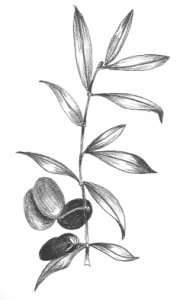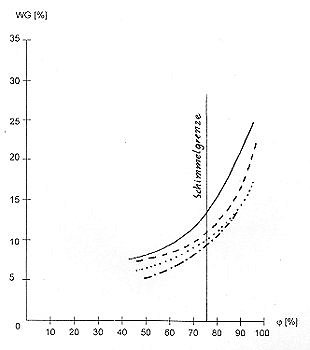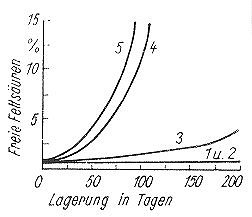Like cereals, oil-bearing seeds/fruits, for example cottonseed, rapeseed (see Fig. 118), olives (see Fig. 119), sunflower seeds and palm kernels are vegetable foodstuffs with a low water content and thus belong to water content class 2 (WCC 2). As living organs in which respiration processes predominate, because their supply of new nutrients has been cut off by separation from the parent plant, oil-bearing seeds/fruits are goods which display 2nd order biotic activity (BA 2).
 |
Figure 118: Rapeseed; Photo: U. Scharnow |
 |
Figure 119: Olive tree branch with olives |
They differ from cereals above all in their high oil content, which may vary within broad limits. Oil-bearing seeds/fruits are used to obtain sweet oils (c.f. Section 18.1). Since shell fruit (nut types), such as Brazil nuts, hazelnuts and walnuts, place the same requirements on transport, handling and storage processes as oil-bearing seeds/fruits due to their similar properties, in particular with regard to their high oil content, these will also be looked at here.
Sunflower seeds and peanuts stand out due to their particularly high oil content; the oil content of babassu kernels, hazelnuts, Brazil nuts, pecan nuts etc. is higher than 60% (see Table 20).
| No. | Product name | Oil content in % | Water content in % |
| 1 | Babassu kernels | 66.0 - 69.0 | 5.0 - 13.0 |
| 2 | Cottonseed | 18.0 - 26.0 | 7.0 - 12.0 |
| 3 | Betelnuts | 20.0 - 36.0 | |
| 4 | Boleko nuts | 20.0 - 36.0 | |
| 5 | Beech nuts, shelled | 27.0 - 44.09 | 9.0 - 14.0 |
| 6 | Cashew nuts | 45.0 - 50.0 | 5.0 |
| 7 | Chufa nuts (earth almonds) | 21.0 - 23.6 | 6.4 - 11.8 |
| 8 | Peanuts | 20.0 - 60.0 | 10.0 |
| 9 | Gall nuts | 62.0 | |
| 10 | Hempseed | 30.0 - 35.0 | 10.0 |
| 11 | Hazelnuts | 50.0 - 63.0 | 6.0 |
| 12 | Hazelnut kernels | 62.0 - 69.0 | 7.0 |
| 13 | Charlock seeds | 26.0 | 10.0 |
| 14 | Illipe nuts | 50.0 - 55.0 | 8.0 - 10.0 |
| 15 | Cacao seeds, decorticated | 50.0 - 60.0 | |
| 16 | Kapok seed | 22.6 - 25.0 | 7.4 |
| 17 | Coconuts | 30.0 - 40.0 | 42.0 - 48.0 |
| 18 | Desiccated coconut | 55.0 - 72.0 | 5.0 - 6.0 |
| 19 | Cola nuts | 1.4 - 2.0 | 12.0 |
| 20 | Pumpkin seeds, decorticated | 45.0 | 5.9 |
| 21 | Pumpkin seeds, unshelled | 38.6 | 7.3 |
| 22 | Linseed | 30.0 - 47.8 | 10.5 |
| 23 | Camelina seed | 31.0 - 35.0 | 8.6 - 9.7 |
| 24 | Lime tree seeds | 8.2 | 12.0 |
| 25 | Lupin seeds | 10.0 | |
| 26 | Almonds | 53.0 - 59.0 | 6.0 |
| 27 | Corn germ, top grade | 30.0 - 48.0 | 4.14 |
| 28 | Poppy seed | 45.0 - 50.0 | 10.0 |
| 29 | Mowrah seed | 50.0 - 52.0 | 5.0 - 10.0 |
| 30 | Niger seed | 40.0 - 50.0 | 6.2 |
| 31 | Oiticica seed | 60.0 - 63.0 | 3.0 - 5.0 |
| 32 | Marrow seeds, decorticated | 50.0 | 3.8 - 5.1 |
| 33 | Oil palm, flesh | 65.0 - 72.0 | |
| 34 | Arugula | 28.3 | 10.1 |
| 35 | Olives, green | 15.3 | 68.0 |
| 36 | Olives, black | 15.0 - 31.0 | 52.0 |
| 37 | Olives, flesh | 40.0 - 60.0 | 28.0 |
| 38 | Olives, kernels | 12.0 - 15.0 | 8.0 |
| 39 | Palm kernels | 40.0 - 60.0 | 4.0 - 8.0 |
| 40 | Brazil nuts | 50.0 - 68.0 | 5.0 |
| 41 | Pecan nuts | 45.0 - 60.0 | |
| 42 | Perilla seed | 44.0 | 8.0 |
| 43 | Plum kernels, decorticated | 41.2 | 12.6 |
| 44 | Pine kernels | 50.0 | 23.0 |
| 45 | Pistachio kernels | 50.0 | 23.0 |
| 46 | Radish seeds | 35.0 - 40.0 | 6.3 |
| 47 | Rapeseed | 38.0 - 42.0 | 10.0 - 12.0 |
| 48 | Rice germ | 19.8 | |
| 49 | Castor beans | 40.0 - 60.0 | 4.0 - 8.0 |
| 50 | Rye germ | 10.0 - 12.0 | 6.0 - 9.0 |
| 51 | Horse-chestnuts | 7.6 | 5.5 |
| 52 | Turnip rape | 40.8 | 8.0 |
| 53 | Safflower seed | 25.0 - 35.0 | 70.0 |
| 54 | Mustard seeds | 15.0 - 35.0 | 5.0 - 9.0 |
| 55 | Sesame seed | 42.0 - 50.0 | 5.0 - 13.0 |
| 56 | Shea nuts | 46.0 - 48.0 | 5.0 - 8.0 |
| 57 | Soybeans | 13.0 - 24.0 | 8.0 - 10.0 |
| 58 | Sunflower seeds | 19.0 - 56.0 | 7.0 |
| 59 | Tobacco seed | 35.0 - 41.0 | 6.0 - 12.0 |
| 60 | Fir seed | 25.0 - 30.0 | |
| 61 | Tomato seeds | 18.0 - 23.0 | |
| 62 | Grapeseed, dried | 16.0 - 18.0 | 7.8 - 10.5 |
| 63 | Walnuts | 50.0 - 65.0 | 2.0 - 3.0 |
| 64 | Wheat germ | 7.0 - 12.0 | 7.5 - 8.8 |
| 65 | Sugar beet seeds | 18.5 | 5.1 |
Table 20: Oil and water content of oil-bearing seeds/fruits [28]
While in cereals carbohydrates predominate and protein and cellulose occur in relatively small quantities, in oil-bearing seeds/fruits protein (raw protein) and cellulose (raw fiber) occur in larger quantities. Sunflower seeds and soya beans stand out in particular due to their high raw fiber content.
Undesirable changes, such as mold and mustiness but especially self-heating and possibly even spontaneous combustion occur as a function of relative humidity and temperature, in particular due to dampening. Oil-bearing seeds/fruits therefore require particular temperature, humidity/moisture and ventilation conditions (SC VII).
Oil-bearing seeds/fruits require ventilated containers in order to dissipate the heat and water vapor formed by self-heating and to be able to receive a supply of fresh air. Protection against solar radiation and stowage below deck are advisable. Due to their sensitivity to moisture and their tendency to release water vapor, oil-bearing seeds/fruits are best transported in a ventilated container.
Hygroscopicity
Due to their oil content, oil-bearing seeds/fruits exhibit some peculiarities with regard to hygroscopicity. For instance, the sorption isotherms in Fig. 120 show that, due to the high oil content, the water content for an equilibrium moisture content of 75% (mold growth threshold) is substantially lower than in cereals.
 |
Figure 120: Sorption isotherms for oil-bearing seeds/fruits
— Soybeans --- Cottonseed ··· Linseed/sunflower seeds -·- Mustard seed |
The oil itself does not exhibit any hygroscopicity. Water is bound above all by minerals and protein, as well as by capillary condensation. Therefore, different equilibrium moisture contents may occur for the same type of oil-bearing seed/fruit with the same water content, depending on its oil content. The higher the oil content of an oil-bearing seed/fruit, the lower the hygroscopicity and the lower the required water contents for storage stability.
Fat decomposition in oil-bearing seeds/fruits
The oil builds up in the seeds or fruit flesh as a nutrient reserve and is stored in them in fine droplets. Fat is a chemical compound consisting of glycerol and fatty acids.
Fat decomposition in oil-bearing seeds/fruits leads to the risk of self-heating and, often, to a cargo fire. Fat decomposition may proceed in two ways:
- by hydrolytic/enzymatic fat cleavage (see Section 13.6.1)
- by oxidative fat cleavage (see Section 13.6.2)
The fat-cleaving enzymes (lipases) are activated by a relatively high water content and light and heat may speed up the process.
The extent to which hydrolytic/enzymatic fat cleavage is determined by water content is clear from Fig. 121. According to the sorption isotherm, the critical water content for cottonseed, for example, is 10%. At water contents of 9.5 - 11.5% and a storage temperature of 15.5°C, hydrolytic/enzymatic fat cleavage and thus the tendency of cottonseed to turn rancid (rancidity) is extremely slight. This results in a long storage life. The free fatty acid content starts to increase at a water content as low as 13.4%. At a high water content of 15.2 - 17%, the free fatty acid content increases so quickly that only short transport or storage times are possible.
 |
Figure 121: Free fatty acid content as a function of storage time at 15.5°C for cottonseed with different moisture contents. Moisture content of cottonseed at 1 - 9.5% 2 - 11.5% 3 - 13.4% 4 - 15.2% 5 - 17.0% Herrmann [17] |
When analyzing Fig. 121, it should be noted that the storage temperature of 15.5°C is still relatively low. When transporting oil-bearing seeds/fruits from the tropics and subtropics, substantially higher temperatures must be expected, which accelerate hydrolytic/enzymatic fat cleavage. The free fatty acids formed are consumed by respiration processes in the oil-bearing seeds/fruits to form carbon dioxide and water, a process which is associated with considerable evolution of heat. Self-heating of oil-bearing seeds/fruits is an extremely vigorous process. Self-heating on exposure to moisture, which may lead ultimately to cargo fire, proceeds in several stages:
- the general biological phase
- the microbiologically particularly active phase
- the thermophilic decomposition phase
- the pyrophoric gas phase (see detailed description in Section 13.6.1)
Fresh oil-bearing seeds/fruits with a high water content, especially fresh peanuts, tend towards rapid self-heating and may ignite. Self-heating of oil-bearing seeds/fruits leads to a reduction in the quality of this product (rancid odor and taste) and also has a qualitative and quantitative effect on oil yield. The heat arising through self-heating of the cargo must be dissipated as quickly as possible by ventilation.
Hydrolytic/enzymatic fat cleavage and respiration may be limited by low temperatures; however, this may only be affected to a limited degree or not at all during container transport. It is therefore important to ensure storage stability by complying with the limit values for the water content.
Peanuts, babassu kernels and copra, when fresh and not warehoused, are at particular risk.
Odor
Oil-bearing seeds/fruits display different behaviors with regard to odor compatibility: some oil-bearing seeds/fruits can have a disadvantageous effect on other goods due to the odor they release (babassu kernels, copra), while others are themselves odorless, so meaning that they can be stowed together with other goods (linseed, sesame seed, soybeans), and still other are themselves odorless but very sensitive to foreign odors (almonds). These different properties have to be taken into account when packing a container.
Contamination
As a result of the high oil content of the goods, dark fat spots often appear on the bags. This should be taken into account if they are to be loaded together with other goods.
Toxicity/Hazards to health
Intensive respiration may result in carbon dioxide concentrations which are hazardous to health and reduced oxygen content. In a container, the danger to health is averted by opening the container doors.
Insect infestation/Diseases
Insect infestation generally occurs during storage prior to packing of the container. When the container is being packed, infestation by pests such as grain moths, khapra beetles, flour beetles, mites, cockroaches, sawtoothed grain beetles, meal moths, dried fruit moths and rats and mice should therefore be looked for. A fumigation certificate may possibly be required.
The increased respiration of the oil-bearing seeds/fruits resulting from pest chewing damage leads to moist spots, which promote mold growth. Molds, such as Aspergillus flavus, produce the carcinogenic mold toxin aflatoxin.